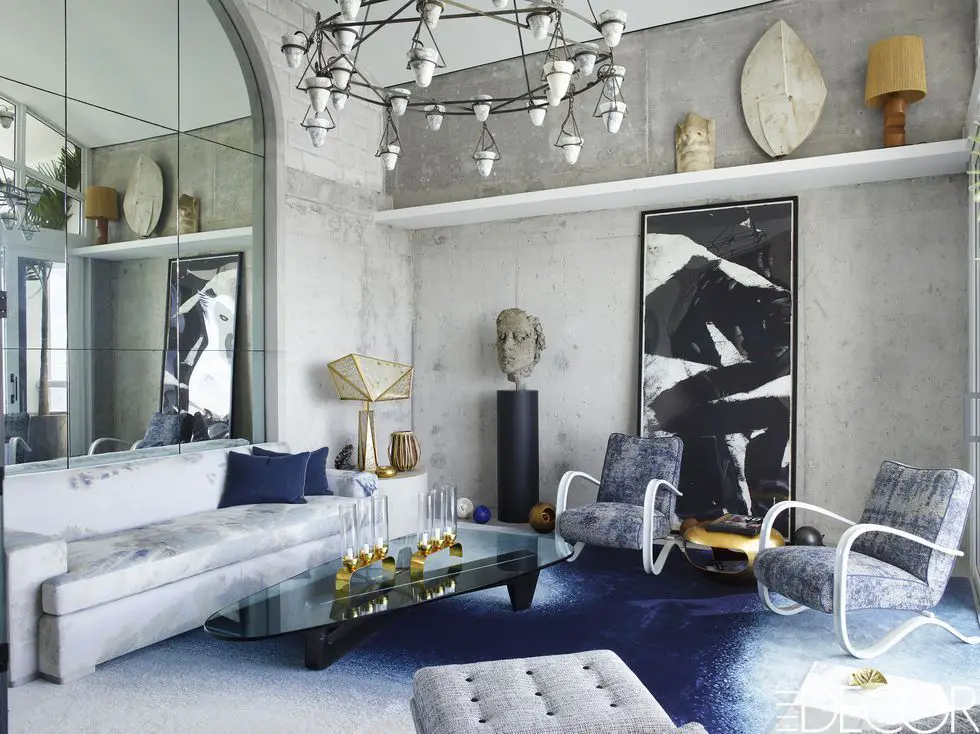Should A Side Table Be Higher Than The Sofa?
A side table, also known as an end table or accent table, is a small table designed to sit beside a sofa, armchair, or bed. Its purpose is to provide a convenient surface for placing items you use while sitting, such as drinks, remotes, books, or decor. The ideal height of a side table in relation to the sofa it accompanies is a common debate among interior designers and furniture buyers.
Recommended Side Table Heights
Typical recommended heights for side tables range from 16-24 inches (40-60 cm) from the floor to the tabletop 1. This provides a comfortable and ergonomic height for resting drinks and accessories within easy reach. The ideal height depends on the style and intended use of the side table.
For more traditional side tables used next to sofas or chairs, a height between 18-22 inches (45-55 cm) is common 2. This allows drinks, books, and decor to be conveniently accessed while seated. Lower side tables around 16 inches (40 cm) work well behind sofas. Slightly taller styles from 22-24 inches (55-60 cm) match counter height seating.
Side tables designed as accent furniture or decorative pieces can vary more widely in height for visual interest. Extra tall lamp tables around 26+ inches (65+ cm) make a dramatic statement. Shorter side tables as low as 12 inches (30 cm) complement sectionals or low seating. The range of 12-26 inches covers most standard side table height recommendations.
Factors to Consider
When choosing a side table height, there are a few key factors to consider:
The most important factor is the height and seat depth of your sofa. The ideal side table height should be within 2 inches of your sofa’s arm height if it has arms. This creates a natural transition from the sofa arm to the table surface for resting drinks, lamps, and other items. If your sofa doesn’t have arms, the table should be around the same height as the top of the sofa seat. Consider the depth of your sofa seat as well – a deeper seat means you may prefer a taller table height for easy reach 1.
Think about how you plan to use the side table. If you’ll primarily place drinks and lamps there, make sure it’s not too low or high for comfortable use. A lower table around 18-20 inches can work nicely for drink resting. For ambient lighting, a taller height around 22-24 inches may position a lamp better. If you’ll use the tabletop for decorative items, choose a height you can view and appreciate the decor 2.
Matching vs Contrasting Heights
There are aesthetic effects to consider when deciding if your side table height should match or contrast with your sofa height. Matching the heights can create a clean, coordinated look. This is especially true if your sofa and side table share similar design styles or materials. A side table height that aligns precisely with the sofa arm can make them appear seamless.
On the other hand, contrasting heights can be used to add visual interest through playing with proportions. A shorter side table next to a taller sofa creates a noticeable difference in heights that draws the eye. The interplay between the two heights adds stylistic flair. This dynamic contrast works well in modern, contemporary, or eclectic room designs.
In terms of functionality, matching heights often provides the most convenient positioning for setting down drinks, books, and other items. A matching height means you can smoothly place objects on the side table surface from a seated position without excessive reaching or bending.
However, if the side table is much higher than the sofa arm, you may need to lift items higher to put them down. And a very low side table will cause you to bend down far while seated. So moderate height differences of 2-4 inches are ideal for both aesthetics and ease of use.
Side Table Styles
When selecting a side table, you’ll first want to decide whether you need an accent table or an end table. Accent tables are decorative and meant to accentuate design elements in a room. They come in a variety of shapes, sizes and materials. End tables are functional – their main purpose is utilitarian, like holding a lamp or drinks. While end tables focus more on function, they can also provide style.
Side tables come in a variety of materials like wood, metal, glass, acrylic, rattan, and more. Wood tables provide a classic, natural look in a variety of stains and finishes. Metal side tables are sleek, modern options available in metals like brass, copper, and stainless steel. For an ultra-modern look, acrylic or glass tables add transparent surfaces. Rattan and wicker tables incorporate natural textures. The shape of the table can also impact its style – round, square, rectangular, oval, and abstract geometric shapes each have their own aesthetic.

Multi-level side tables offer additional surface area and visual interest through varied heights and tabletop shapes stacked together. For example, a two-tier side table combines a small round upper tier with a larger square lower tier. Three-tier accent tables can incorporate multiple sizes, shapes and even materials for lots of character.
Lamps and Lighting
Properly sized lamps that provide adequate lighting are an important consideration when selecting a side table. Experts recommend choosing a lamp that is in proportion to the height of the sofa or chair it sits next to. As a general guideline, the lamp should be 1.5 times the height of the table or 24″ to 34″ tall to be at eye level when seated (Furniture Row). Having the bottom of the lampshade align with eye level creates an ambient glow that is ideal for reading or other tasks.
It’s also important to ensure lamps are accessible and easy to operate from a seated position. Side table lamps that are too tall or short can be frustrating to adjust. Selecting the proper height lamp based on your furniture dimensions will provide better functionality.
Drink Placement
When considering a side table for drink placement, the optimal height will allow you to comfortably set down and pick up a glass or mug without excessive reaching or spilling. Most design experts recommend choosing a side table height in the range of 16-22 inches for drinks.
For example, the home experts at Wayfair advise choosing an end table that is within 2 inches of your sofa’s arm height for drink placement: “End tables should be within two inches of a sofa’s arm height. For example, if the sofa’s arm is 22″ tall, a proper end table can be anywhere from 20″-24″ tall.”
A side table height on the lower end of the range, around 16-18 inches, can help prevent spills and make it easy to set down drinks without overreaching. Using coasters is also recommended to prevent condensation rings and water marks.
Decorative Items
When styling your side tables with decorative items, it’s important to create visual interest through varying heights while also avoiding clutter. Some ways to accomplish this include:
Mix tall and short objects – Place taller items like books or vases behind shorter objects like candles or small trays. The height contrast makes a more dynamic display.
Elevate key pieces – Use decorative risers, stands or acrylic boxes to lift select accessories above the table surface. This adds dimension.
Incorporate negative space – Don’t overcrowd the surface. Leave some open areas to let the tabletop show through for balance.
Limit colors – Stick to 1-3 colors in your accessories so the look stays cohesive. Neutrals like white, wood and metal make it easy to mix and match.
Rotate seasonal decor – Change out some pieces seasonally to keep the look fresh. This prevents clutter from accumulating.
Take advantage of multi-level tables – If your side table has built-in shelves or stacked surfaces, make use of the different levels to display a thoughtful selection of decorative items. For example, place books and candles on the bottom shelf, a plant on the middle shelf, and a lamp on top.
Vary textures – Incorporate different textures like ceramic, glass, metal, wood, wicker, etc. The mix of smooth, rough, matte and shiny creates visual interest.
Group like items – Clustering similar objects (like a trio of candles) looks more cohesive than scattering lone items. Leave some negative space between each cluster.
In summary, carefully curating and elevating decorative accessories makes side tables more interesting and enjoyable to look at. Prioritize quality over quantity, and edit ruthlessly to avoid a messy, overwhelming appearance.
Personalization for Function
When selecting a side table height, it’s important to consider accessibility and personalization for different users and their needs. For example, adapting the height for elderly individuals or those with disabilities is an important factor.
The ADA (Americans with Disabilities Act) provides guidelines for accessible table heights. An accessible table surface should be no higher than 34 inches and no lower than 28 inches above the floor. At least 27 inches of knee clearance underneath is also recommended for wheelchair accessibility (ADA Guide).
For elderly individuals or wheelchair users, a lower table height around 28-30 inches may be preferred for easy reach and use. The standard coffee table height of 16-18 inches can make accessing items difficult for some.
It’s also important to consider countertop overhangs in kitchens and other spaces. Allowing adequate knee clearance underneath with a reduced table height is key for accessibility (ADA Kitchen Guidelines). Adjustable height tables are another option to accommodate different needs.
Overall, personalizing the side table height for the intended users and their unique accessibility requirements allows for a more functional and ergonomic setup.
Conclusion
While there are certain guidelines for side table height in relation to sofas and chairs, ultimately the ideal height comes down to personal preference and the style of your living space.
Style experts generally recommend the table be 0-4 inches higher than the sofa arm for easy drink/book access. However, some prefer a lower height for a clean sightline. Tables that are up to 2 inches lower or 4 inches higher than the sofa arm can work well.
The range of viable side table heights is generally between 16-28 inches. Shorter tables around 16-20 inches pair well with low or mid-height sofas and chairs. Taller tables from 24-28 inches match better with taller furniture. This creates an aligned look.
Consider function – lower tables hold drinks without reaching while taller ones better display decorative objects. Measure your sofa arm height, then choose a matching or contrasting table height based on your space and needs.
Ultimately side tables, like most furnishings, come down to personal style and taste. Don’t be afraid to break the “rules” if a different height better suits you.



